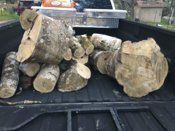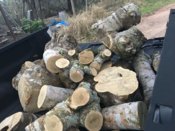- Messages
- 2,993
- Reaction score
- 6,006
- First name
- David
or subtitle: “ Don’t tell a Texas girl with a chainsaw what she can’t do!” ( and a husquie at that!)
Was perusing fb yesterday when I saw a post from one of my friends— that she had decided a Holly tree had to go! She had posted that she had most of it cut, but still had some “big” stuff to do. Fortunately was able to get her to let me finish the cutting. I had a few doubts of whether it was Holly, but my gosh—- it was! Pointy leaves, red berries and white wood!
My Stihl made short work of the stump— got 2 nice bigger pieces; she had started a cut yesterday.
Still have to seal ends.
Does Holly check much? Never seen it.


Was perusing fb yesterday when I saw a post from one of my friends— that she had decided a Holly tree had to go! She had posted that she had most of it cut, but still had some “big” stuff to do. Fortunately was able to get her to let me finish the cutting. I had a few doubts of whether it was Holly, but my gosh—- it was! Pointy leaves, red berries and white wood!
My Stihl made short work of the stump— got 2 nice bigger pieces; she had started a cut yesterday.
Still have to seal ends.
Does Holly check much? Never seen it.


Last edited:
